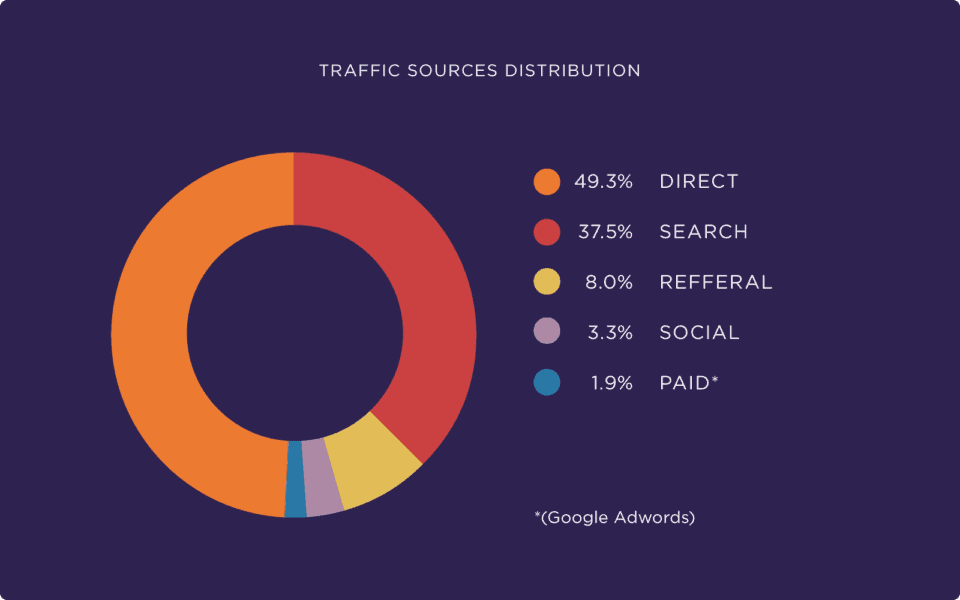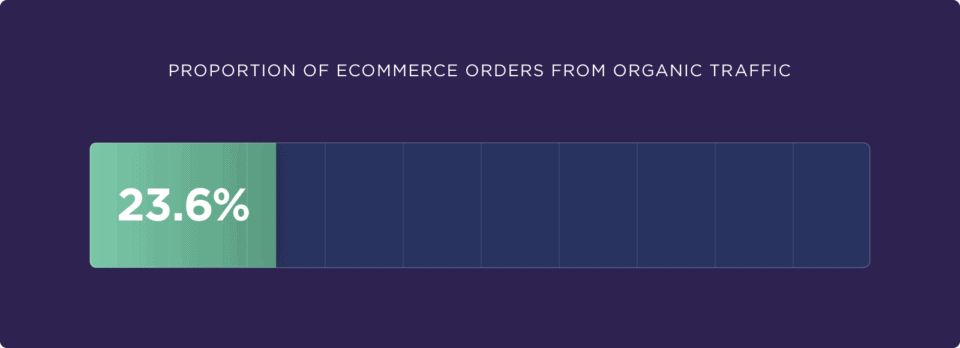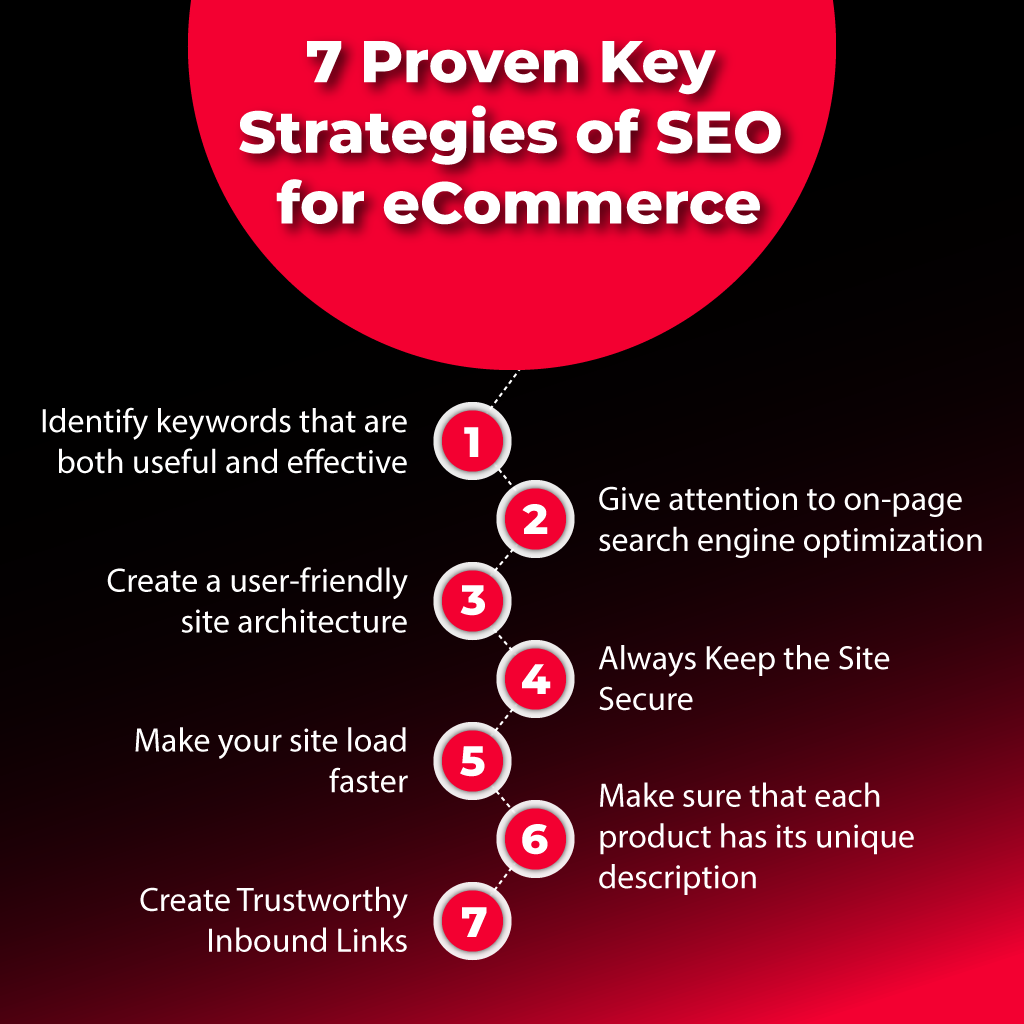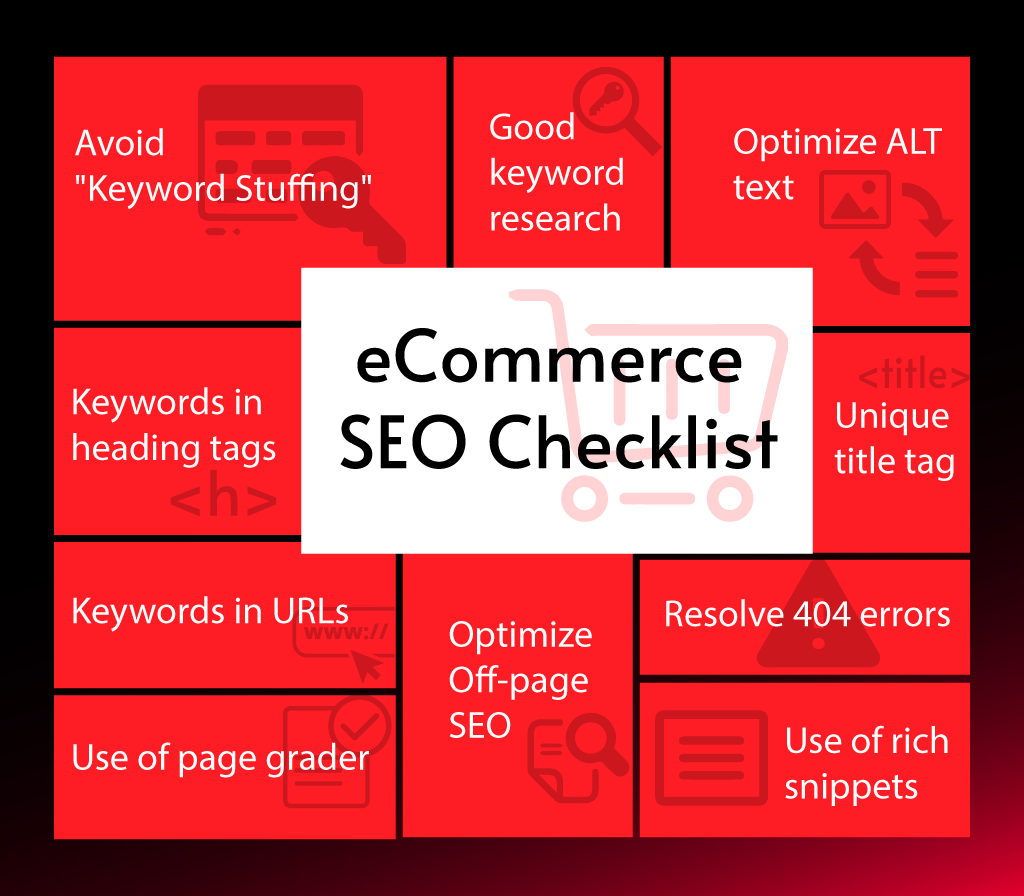eCommerce SEO is crucial if you are in the business of selling things and want to attract the largest potential customer base.
Before we discuss and plan out the entire guide for SEO for eCommerce, here are some facts based on stats.

According to SEMrush, Search engines drive 37.5% of all traffic to online stores. Also, according to Business Insider – Explicitly linked to organic traffic, 23.6% of online sales may be traced back to it.

SEO is important for any website, but it has a particularly large impact on eCommerce websites. This is because, when looking to buy anything online, most individuals will utilize a search engine to locate what they need rather than looking for an e-commerce website.
Therefore, it is important to have an SEO for eCommerce website so that it is shown to the audience interested in your speciality before the other websites competing for their attention, resulting in more traffic and sales.
By definition, what is eCommerce website SEO?
eCommerce SEO involves increasing traffic to your website via organic search results (SERPs). You want to be as high up in search engine results as possible for the things you offer.
Paid search may provide visitors, but organic search engine optimization has considerably less impact on your budget. The paid search might be less successful with ad blockers and blindness, but you still need to optimize for search.
SEO for eCommerce often entails tweaking the title tags, meta data, internal link structure, and navigational structure to improve rankings in search engines and the user experience. You need a specific page for each product you offer optimized for search engine traffic.
Before we learn how to do SEO for eCommerce, understand why search engine optimization is crucial.
When people need a product or service, what do they often do? Many people perform searches on Google. They want to know their choices, how to improve their chances of success, and how various alternatives stack up against one another.
Not having your website appear on search engine results pages (SERPs) may be disastrous for your online store. It’s great that you’ve got an online presence, but how discoverable are your wares?
This is where SEO for eCommerce websites comes in. It allows you to communicate without spending money on advertisements with your intended audience. After luring visitors to your site, you may wow them with top-notch offerings, engaging content, and compelling CTAs.
Your business will suffer if you ignore search engines in favour of human visitors. Regarding eCommerce, SEO tackles the initial problem: drawing in visitors.
Now it is time to learn SEO tips for eCommerce and how to do SEO for eCommerce.
How to do SEO for eCommerce? 7 Key Strategies

If your e-commerce website currently has many items, optimizing it for search engines may seem daunting. It might take some time, but a good plan can speed things up considerably.
1. Identify Keywords that are Both Useful and Effective
Regarding the eCommerce SEO checklist, keywords play a pivotal role; as such, you must keep a keen eye out for the right keywords while you develop your online store’s content. Use keywords that have substantial relevance to the goods you’re selling.
You need to know how often people use a term, how much it costs per click, and what they want to accomplish before you can utilize it on a product or category page. Researching the competition’s website for keyword inspiration is another viable strategy for eCommerce SEO. However, long-tail keywords are suggested because they can better match user intent and boost conversion rates.
For instance, if your website sells men’s clothing, you may optimize it using the phrases “blue t-shirt for boys,” “white round-neck men’s shirt,” etc. Find appropriate and optimized keywords for your site with the help of one of the many keyword research tools accessible today. Several examples follow:
- SEMrush
- WonderSearch
- Keyword In, etc.
2. Give Attention to On-page Search Engine Optimization
On-page SEO has always played a crucial role in search engine optimization for online stores. In the context of an online store, on-page optimization is working to improve how individual product and category pages fare in search engine results for targeted keywords.
While many of the same On-Page SEO tactics that apply to other websites also apply to eCommerce sites, there are a few key differences that you should be aware of. The following are examples of some of the most important On-Page SEO methods for an online store:
- Meta titles and descriptions should be optimized.
- Make URLs that are both memorable and search engine friendly.
- Incorporate both the primary and LSI keyword phrases into your product descriptions.
- Include Schema Markup on your site.
- Take action, such as internal linking.
Meanwhile, incorporating genuine, relevant, and high-quality images or infographics might potentially boost your results. On-page SEO for a commerce site should focus on both search engine rankings and the quality of the user experience since the latter is what will ultimately convince visitors to return.
3. Create a User-friendly Site Architecture
The navigation procedure of your website is one of the primary considerations of an eCommerce site architecture, as is how the website is composed of web pages devoted to products or categories for eCommerce SEO.
The consumers and the search engine should easily use it since it should be straightforward and uncomplicated. While you are working on the architecture of the site, there is an important guideline that you must constantly keep in mind.
The rule indicates that reaching any product page from the homepage should take no more than three clicks.
4. Make Your Site Load Faster
Let’s say you’ve decided to do some online shopping and have access to a computer, tablet, or smartphone. You decide that you need a new watch and start browsing online. When you click on the first shopping site on the search engine results page (SERPs), you wait a considerable amount of time for it to load and become usable. Where do you go from here? Leaving that website behind is an absolute certainty. That’s when things start to change.
A sluggish website may lose you a lot of business, even if you have great items, great service, or all the other usual qualities in the world. In addition to the user’s viewpoint, search engines also suggest that site speed is a consideration in their ranking algorithms, which implies that the quicker your site will load, the better it will be ranked.
So, having the site load faster is one of the key SEO tips for eCommerce.
Shopping online may be frustratingly sluggish due to the presence of large graphics. While product photos are a huge part of an online store’s success, you shouldn’t skimp on quality just because you’re selling online.
5. Make Sure That Each Product has Its Unique Description
Regarding eCommerce SEO, it is the single most overlooked factor. This is understandable given that an online store may have several items from the same category, making it tedious to describe each individually.
However, duplicate content concerns resulting from identical descriptions might hurt your site’s rankings, reducing traffic and conversion rates. Because of this, it’s more important than ever to provide each product with its own appealing and original description.
Have you ever felt you’d read a website’s information before? When online shops reuse product catalogues and photos, they are not uncommon to have similar production and category descriptions.
It’s easy to see why many online merchants recycle old product descriptions. This is usually the result of having insufficient internal resources for producing original content. The quantity of duplicate content on your site, such as product descriptions, may be drastically reduced even if you don’t have time to update everything.
6. Always Keep the Site Secure
Due to the nature of an e-commerce platform, which handles the personal information of millions of users and facilitates thousands of transactions daily, website security is paramount. Moreover, visitors grow warier and desire a more secure website due to the constantly rising cyberattacks on e-commerce platforms, such as leaking banking details, account hacking, etc. Moreover, the search engine does factor in your site’s security when determining its position in search results.
If you own an online store, the most important thing you can do to secure customers’ personal information is to ensure your site is encrypted and uses the HTTPS protocol and an SSL certificate. HTTPS (Hypertext Transfer Protocol Secure) and SSL (Secure Socket Layers) enable a browser to establish an encrypted connection to a server using a regular port.
It is also important to regularly back up the site’s data in case any of it ever becomes corrupted or otherwise inaccessible, allowing you to restore it with little fuss to your users. You may also maintain your website up-to-date and suggest that your consumers change their account passwords regularly.
7. Create Trustworthy Inbound Links
For as long as anybody can remember, backlinking has been held in the highest esteem as the gold standard of search engine optimization (SEO) for any website. It’s always important to have good SEO. Still, it’s especially important to have good SEO for eCommerce website since a positive recommendation from a credible source might significantly increase visitors.
To avoid penalizing your site for spammy or irrelevant links, remember to only connect to credible, authoritative resources within your field while creating backlinks. E-commerce site backlinks may be built in many different methods, including distributing informational visuals on social media, directory submission, using question-and-answer websites (such as Quora), and many more.
Search engines favour Guest Blogging as the greatest method to get high-quality backlinks. You may easily publish blogs that pertain to your topic; however, you should ensure that the information you publish is useful to your visitors and not only for link-building purposes.
Also Read: How To Optimize Your Website For SEO?
eCommerce SEO Checklist

Well, we have described the best possible strategy for eCommerce website SEO. However, keep the following eCommerce SEO checklist in mind:
- You must conduct a good keyword research
- Write a unique title tag
- Don’t forget to have keywords in heading tags
- Put reference Keywords in Your URLs
- Try to optimize Alt Text and Image Names
- Try using Rich Snippets
- Don’t forget to use page grader for your website
- Resolve 404 Errors and Warnings
- Optimize Off-Site SEO with Backlinks
- Avoid “Keyword Stuffing”
Wrap Up
Are you feeling overrun with eCommerce SEO? Believe us; you are certainly not alone.
One individual can’t be responsible for everything. eCommerce SEO is very difficult since product pages, landing sites, and content pages must be optimized simultaneously.
Suppose you are seeking assistance and insights. In that case, our team will do a free-cost full SEO audit to understand what you are doing properly and where you need to improve. If you are interested in working with us, please get in touch with us. During a free consultation, let’s talk about the possibilities of search engine optimization for your online store.
If you want to hire a top-class eCommerce SEO agency – contact us at [email protected] or call us on +91 9054331400.
